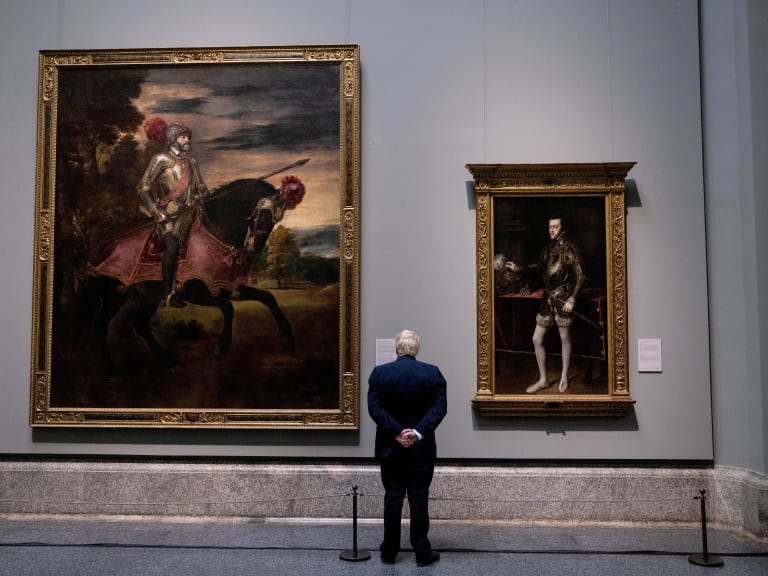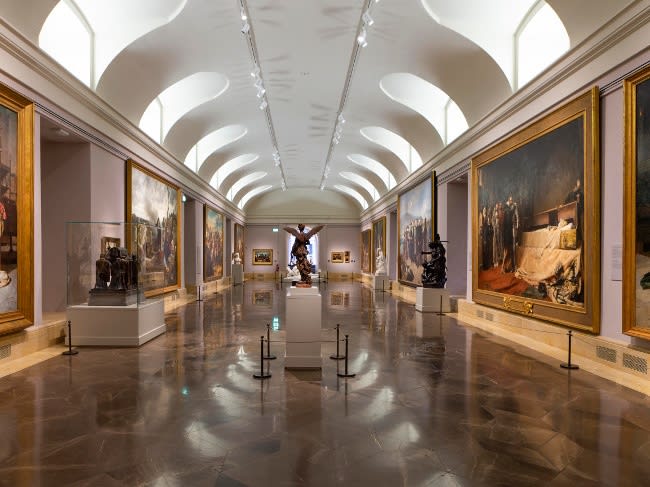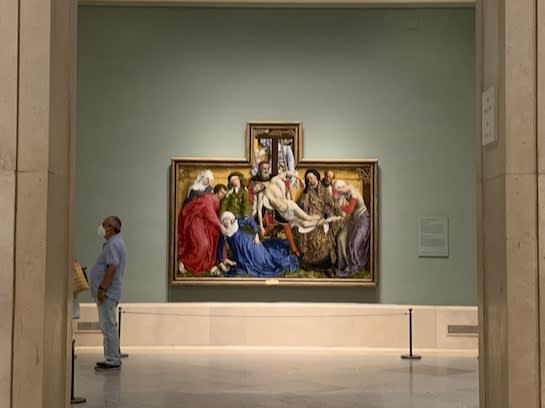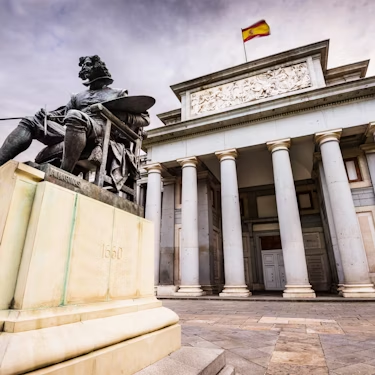More about: Prado Museum in Madrid: Tickets and Tours
The Prado Museum is the jewel, not only of Madrid but of the whole of Spain and a large part of Europe. The names associated with one of the most famous art galleries in the world are Velázquez, El Greco, Raphael, Goya, Rubens and Bosch.
Buying tickets in advance and online is the best way to ensure a visit to the Prado without queues and with more peace of mind, to avoid entering the museum already tired after a long wait. These are, in order, the best online options to visit the Prado:

Madrid Prado Museum Guided Tour
The best of the Prado, from the hand of an expert guide
Perfect for a tour of the essential works of the Prado Museum, accompanied by a professional.
This two-hour tour of the Prado Museum will allow you to see the most important paintings of the museum with an expert guide. You can appreciate the quality of the art for yourself, but the messages behind each work are what is truly fascinating about this museum. When you are in front of works such as Las Meninas, El Jardín de las Delicias or Los fusilamientos del 3 de mayo, don't be in a hurry to move on to the next one.
You will see that I have put this option ahead of the individual ticket because in a place like El Prado, with so much history and symbolism behind its corridors and each of its works, I believe that an introductory guided tour of about two hours is the best way to get to know the museum and make the most of it. The group will have a maximum of 30 people.

Why I like this option: I think a guided tour of the Prado is essential due to its size and the large number of works it houses. With this option, moreover, you will do it at the best price.
Recommended if... you want to take a guided tour of the Prado without investing too much time or budget to see the most essential works of the museum.

Madrid Prado Museum Guided Tour
The essentials of the Prado with an expert guide just for you
Tour the Prado in the most intimate experience with an art expert who will accompany you and your companions exclusively.
If the option of a guided tour of the Prado appeals to you, don't rule out taking a private tour of the Prado Museum. The price is a little higher than the standard guided tours, but the guide will be dedicated exclusively to you and your group.
The tour begins with a brief tour of the Paseo del Prado and its main points of interest, such as the Casa de América, the Cibeles Fountain and the Neptune Fountain. The guide will explain the details of the essential attractions in the centre of Madrid before moving on to a guided tour inside the Museum. The tickets included in this tour also allow you to skip the queues at the ticket office, which makes the tour much more enjoyable and fluid.

Why I like this tour: Although the price is higher than the other options, this guided tour offers a more premium and complete experience, as in addition to the private visit to the Prado, the guide will give you a brief tour of the surrounding area.
Recommended if... you want to get to know the surroundings of the Museum a little better and enjoy the intimacy and exclusivity of having a guide just for you.
In summary, we compare the options:

The best of the Prado, from the hand of an expert guide
Perfect for a tour of the essential works of the Prado Museum, accompanied by a professional.

The essentials of the Prado with an expert guide just for you
Tour the Prado in the most intimate experience with an art expert who will accompany you and your companions exclusively.
Buy tickets for the Prado Museum at the ticket office

In front of the imposing building of the Prado Museum you will see gardens dotted with classical statues and bounded by cobbled paths. All this would be very nice if there weren't queues of visitors that can reach several metres long at certain times of the day... If you still decide to buy your tickets at the ticket office, I recommend that you do so first thing in the morning to avoid the crowds of tourists.
Plan your visit to the Prado

When to go
The Prado Museum is open from Monday to Saturday from 10am to 8pm and on Sundays and public holidays from 10am to 5pm. The best time to go and not find too many people is on weekday mornings, as the free opening hours begin in the afternoon and the number of visitors is much higher.
How to get to the Prado
The Prado is located on the Paseo del Arte in Madrid, between the Botanical Gardens and the Cibeles fountain. The nearest metro stop is Atocha and you can easily find its location on any map. The entrance gate is at the end closest to Cibeles and is preceded by a set of double staircases.
Audioguide
Visiting the museum with an audio guide is a must for me, at least on the first visit. It is available at the entrance for four euros in several languages and, although some explanations can be a bit dense, it is worth it. Of course, you will always enjoy a guided tour more.
The Prado with children

The Prado Museum is one of the best adapted for children; they have an audio guide with video for the visit in which animated characters explain the paintings in their own language. Be sure to take them to see the museum during their visit to Madrid.
Where to eat
Near the museum you won't find many restaurants, although there is a Starbucks and a Museo del Jamón (ham sandwiches for one euro to eat standing up) on the pavement in front of the museum. If you walk to the centre you will find many more restaurants to eat at although the most typical taverns tend to be in the Barrio de las Letras or in other more distant areas such as Lavapiés or Malasaña.
Around El Prado
The Paseo del Arte is a beautiful place to stroll around, and when you visit the museum you can get off at Atocha and walk up the slope of the booksellers that leads to the Retiro; there you will find street stalls with hundreds of art books, novels and real treasures if you know how to look for them. Save a visit to the Retiro Park for another time and head up through the Botanical Gardens in the direction of the museum (past the station).
Behind the museum, up the stairs, is the fabulous church of San Jerónimo el Real; the views from the museum are breathtaking. When you finish your visit you can walk to Cibeles and from there go down to the centre along Gran Vía towards the Metropolitan building, one of the most emblematic in Madrid.
Very close to the Prado is also the Reina Sofía Museum, highly recommended for art lovers. Here is a practical guide to help you organise your visit to the Reina Sofía: Reina Sofia Museum in Madrid: Tickets and Tours.
If you visit the Prado Museum with children, there is an audio guide with video adapted for them, which will help them get to know art in a fun way.
What works to see at the Prado

You can see the Prado Museum in two hours (if you go on a guided tour and are guided through its most important paintings) or you can spend five hours touring the galleries. The length of your visit depends on you and your interest in art. In any case, there are works that you should not miss in any case.
Making a selection of must-see works at the Prado Museum is very difficult; as you add one to the list, you will remember two others that you can't miss. Take this as a very small personal selection:
Las Meninas by Velázquez
This is a family portrait in which the painter captures the moment when the Infanta Margarita accompanied by her ladies-in-waiting (the Meninas) enters the room in which he himself (himself self-portrayed in the painting with the cross of Santiago) is working. You will find different legends and secrets behind this painting, so be sure to activate the audio guide or do some research before you go to see it.
The Garden of Earthly Delights by Bosch
This is my favourite painting and I visit it every time I go to the museum. Heaven and hell are portrayed in this triptych that doesn't let you take your eyes off its many details. From my point of view, it is impossible not to feel anything in front of this painting, so my advice is to first take a close look at it and then listen to its story.
Goya's Firing Squad of the 3rd of May
If you have already visited the Temple of Debod during your visit to Madrid, you will surely have admired the views from that hill. What you may not know is that it was on that spot that the leaders of the revolt against Napoleon on 2 May 1808 were shot. The painting is an excellent recreation showing the soldiers as faceless men and the leaders of the revolt in their death throes.
The 3 Graces by Rubens
The Baroque ideal of beauty was far from today's, which is perhaps one of the reasons why Rubens' painting has been vindicated over the years. Chastity and mythology are themes that converge in this painting.
The Annunciation by Fran Angelico
Many painters have depicted biblical scenes in their paintings. In fact, if you do a little research you can discover the messages that were said to be hidden behind many of these paintings; you have a whole range of secrets and conspiracies at your disposal. This religious painting is one of the most famous in the museum; ask your guide for its meaning if you go on a guided tour - you might be surprised.
The Descent from the Cross by Van Der Weyden

Everyone feels something different in front of every painting, but without going into the story behind it, this painting has always caught my attention because of the level of detail and the range of colours that seem to pop out of the painting. Take your time to observe the details of the folds and shadows of the clothing and then put the audio guide to work to identify the characters that appear in the painting.
Saturn devouring his children by Goya
Goya's black paintings are quite a shock for those who are only familiar with the artist's most classic works. Placed in a separate room, it is inevitable to look at them and feel some of the anguish that surrounded the painter during the last years of his life. This is one of the best known in the collection and its expressiveness is overwhelming.
Goya's Nude Maja
Little would they have imagined a few centuries ago that a painting confiscated by the Holy Inquisition and subsequently kept in a dark room would today be one of the most visited paintings in the Prado Museum. Alongside La maja desnuda you can also see La maja vestida. The big question about this painting is who inspired Francisco de Goya to paint it; one of the most widespread theories is that it may have been the Duchess of Alba.
The Fable of Arachne by Velázquez
The name of the painting may not ring a bell, but if it is called The Spinners, you are more likely to know which work it refers to. This is one of Diego de Velázquez's most enigmatic paintings, as historians do not agree on what the painter wanted to convey with the painting.
The Forge of Vulcan by Velázquez
In Madrid there is a well-known bar named after this painting, which for years has been one of the most studied paintings in schools. In it, Velázquez depicted a mythological scene between the God Apollo and the God of Fire (Vulcan) who made all the metal objects on Olympus. The former is going to tell the latter that his wife Venus has fallen in love with Mars, the god of war.























